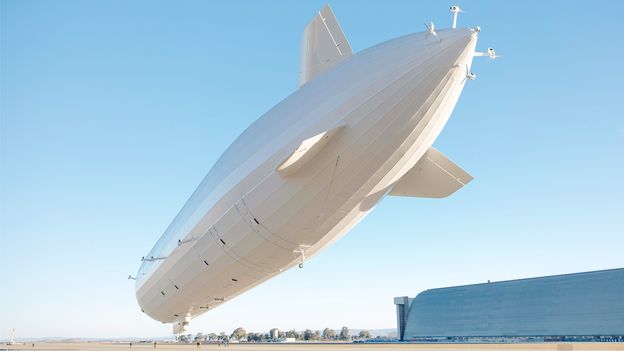
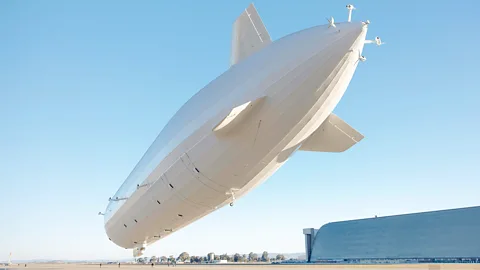
LTA Research
Pathfinder 1, supported by a billionaire co-founder of Google, aims to rejuvenate the airship industry. A century after notable disasters, is this venture sufficiently secure?
On October 24, 2024, a brief message was posted on LinkedIn. This announcement from Sergey Brin’s airship firm, LTA Research, highlighted the successful completion of Pathfinder 1’s inaugural untethered flight at NASA’s Moffett Field in California. “This morning, Pathfinder 1 celebrated a significant milestone: its first outdoor flight without tethering. This successful test is a crucial step forward in our endeavor, and we are eager to continue building on this achievement through thorough testing,” they stated.
In the words of Alan Shrimpton, editor of the Airship Journal, “Pathfinder 1 is an extraordinary vehicle. This is the first fully rigid airship of this magnitude to fly in many decades, and there was significant anticipation that it would take to the skies soon after outdoor testing commenced.”
“However, Alan Weston [the founder and former CEO of LTA Research] has always emphasized that previous haste in developing rigid airships was a pitfall, and they planned to meticulously test every aspect—this commitment was upheld,” he added.
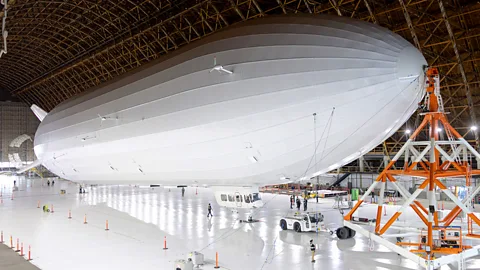
LTA Research
The understated nature of LTA’s announcement underplays the remarkable achievements of Brin’s venture thus far. This flight marked the debut of the first airship created by the Google co-founder’s team, the initial flight of a traditional-sized rigid airship since the 1930s, and the arrival of a new era of airships. The last notable rigid airship, Graf Zeppelin II, completed its final flight on August 20, 1939, just days before the outbreak of World War II, ultimately meeting its end in 1940. Rigid airships feature a complex metal framework supporting a substantial envelope that holds enough helium or hydrogen to lift many passengers or substantial cargo for extended periods.
Nonetheless, the tragic crash of the Hindenburg airship in 1937, which resulted in 36 fatalities including one individual on the ground, highlighted the significant risks presented by the flammable gas utilized for buoyancy. Subsequently, airships fell out of favor as advancements in conventional aircraft design progressed rapidly.
Fast forward 86 years to November 2023, when Pathfinder 1 finally emerged from the historical Hangar Two at Moffett Field to commence its outdoor flight-testing journey. Nevertheless, the world’s largest aircraft remained grounded, disappointing numerous aviation enthusiasts eagerly awaiting its first flight.
Utilizing this newfound freedom, the team has explored innovative materials that surpass traditional lightweight aluminum alloys for constructing the extensive framework of a rigid airship. They’re employing cotton-composite substances and even organic materials to create the envelope, all while enhancing their understanding of the aerodynamics unique to large airships. It appears they have progressed cautiously with their flight tests, avoiding overconfidence and investor pressure that have historically plagued similar projects.
Pathfinder 1 is a contemporary innovation, not a historical duplicate.
“Many doubted it could be accomplished, labeling it impossible,” remarks Janne Hietala, CEO of Kelluu Airships. Their fleet of 10 autonomous drones, capable of being transported in a 12m (40ft) shipping container, currently holds the distinction of being the “largest airship fleet worldwide.” “This endeavor is commendable and ambitious, addressing the engineering challenges necessary for mass-producing large airships. Though it might be challenging to create hundreds of such vessels, it’s certainly feasible.”
Pathfinder 1 serves as a proof-of-concept, aimed at assessing whether a rigid design can be modernized with contemporary materials.
Particularly, LTA Research seeks to tackle the complex issue of how to mass-produce aircraft of this scale. Their ambition includes the construction of production models at the Goodyear Airdock in Akron, Iowa, the historical site where America’s formidable rigid airships of the 1930s were constructed.
“I’ve visited Moffett Field to observe Pathfinder 1 twice, and witnessing it in person is truly remarkable,” shares John Geoghegan, author of *When Giants Ruled the Sky*. “It’s striking to see how much they’ve learned from past endeavors simply by observing it from the outside.”
The absence of traditional cross-shaped tail fins, which have been adjusted to an angle, exemplifies this learning curve since airships ascend and descend from a mooring mast, often damaging their lower tail fins. Additionally, the positioning of the airship’s engines is now staggered along its body to minimize wind drag and vibrations that plagued earlier designs. Furthermore, it employs helium instead of hydrogen as the lifting gas, preventing the catastrophic fires that marred the airship’s golden era.
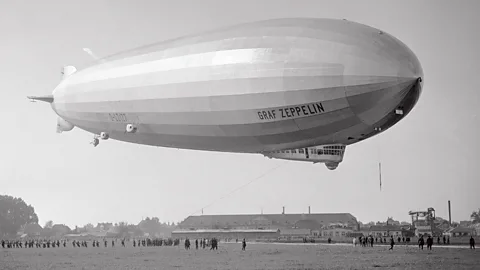
Getty Images
While helium is significantly less flammable than hydrogen, it comes with its own challenges. Helium generates less lift and is also in limited supply, which leads to higher costs when filling an airship’s envelope with it.
“There’s an abundance of pre-existing misconceptions surrounding airships, and many individuals possess fixed ideas about them. As such, this team is being exceptionally prudent and deliberate in sharing their progress,” Geoghegan notes. “They aim to avoid further negative media attention as public memory tends to focus on airship catastrophes, overshadowing successful flights.”
The inaugural untethered flight of Pathfinder 1 has broader implications for the lighter-than-air industry, which has long relied on impressive graphics to attract investors. With this flight, companies can finally demonstrate that airships can indeed take to the skies, particularly at a time when other notable airship ventures, like Flying Whales, are facing challenges in establishing their primary production facilities, offering a morale boost for the sector, according to Shrimpton.
“Investors often say they’re interested in funding airship initiatives but need to see at least one operational flight first,” he explains. “Now they can show that.”
The aviation sector is eagerly seeking decarbonization options, and airships could play a role in that solution. – Diana Little
“It’s remarkable to see LTA Research making such strides with modern technology to tackle these challenges,” remarks Diana Little, co-founder of airship startup Anumá Aerospace. “It serves as a reminder of the potential of lighter-than-air flight.”
“Aviation is a sector actively searching for sustainable solutions, and airships are a part of that puzzle,” Little adds.
The inaugural flight of Pathfinder 1 has its roots in over a decade’s worth of development. Brin’s fascination with airships appears to have started in 2012, coinciding with the launch of a contemporary semi-rigid Zeppelin NT that began tourist excursions from Moffett Field.
In the year that followed, Brin established LTA Research Ltd. By 2017, his airship organization had secured a location at Moffett Field and research activities kicked off at the Akron Airdock. During this phase, they constructed a 12-engine, 50-foot-long (15m) electric “baby airship” to trial their technology.
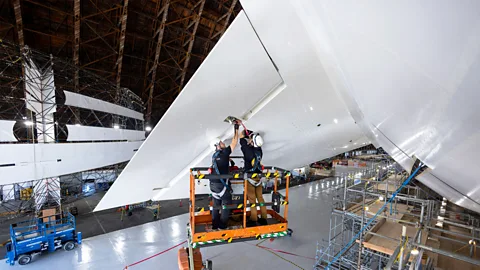
LTA Research
For decades, there has been no production of aircraft resembling these massive rigid airships. As a result, engineers took time to grasp the necessary construction techniques, with an emphasis on safety to avoid repeating historical mistakes. In the 1930s, the materials chosen for building rigid airship frames and envelopes were insufficiently robust to withstand the pressures of flight.
Today, computer-aided controls alongside innovative, lightweight materials like carbon fiber and titanium have propelled the rigid airship into the 21st century. Improvements also include flame-retardant synthetic materials for the airship’s envelope, helium monitoring sensors, and engines with adjustable thrust.
The engineering knowledge of renowned past engineers had to be combined with contemporary research and technology for the design and possible mass-production of even larger vessels in the future. Instead of requiring engineers to utilize precarious high ladders, LTA constructed a massive cradle-like assembly system that allows workers to operate from the ground as the airship gently rotates before them. This innovative approach has necessitated finding skilled workers willing to participate in a potentially groundbreaking aviation project while LTA continues to search for qualified personnel.
Initiatives began in 2017 at Moffett Field for LTA’s smallest airship, Pathfinder 1, with plans underway for Pathfinder 3, its larger successor, which is expected to be one-third larger. (Notably, there is no Pathfinder 2.)
Interest in airship technology goes through cycles – John Geoghegan
Nevertheless, a complete resurgence of large airships is not guaranteed. “I am cautiously optimistic,” Shrimpton admits, “but if more incidents were to occur during flights with Pathfinder 1, the focus would revert to the inherent risks of large airships, potentially thwarting the entire airship passenger/cargo transportation sector.”
The same predicament applies to other airship companies like Flying Whales, which is still in the early phase of development. “They, too, must overcome this crucial challenge of demonstrating that they have a safe craft, as LTA Research has done,” Shrimpton observes.
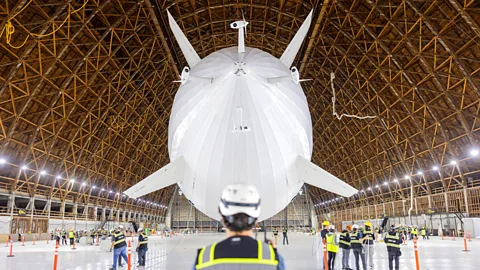
LTA Research
Geoghegan expresses a more positive outlook, stating, “Interest in airships tends to go in waves. Approximately every 10 to 15 years, a new company emerges in the sector, with a few more popping up alongside it. Occasionally, some manage to launch prototypes, but none seem to have sustained success.”
However, a degree of apprehension lingers within the investor community regarding the construction of these colossal ships. Concerns revolve around whether the technology is sufficiently robust, along with questions about the practical applications. Is there a viable market that can financially support airships on such a grand scale?
“Repeatedly, we hear about various potential markets: tourism, disaster relief, a greener alternative to conventional aircraft, and specialized cargo transport,” Geoghegan points out. “But I’m still unconvinced about the economic rationale behind such options.”
Clearly, the engineering challenges ahead for LTA remain formidable.
“Ultimately, LTA Research requires proof that their design functions effectively, marking a key milestone for their dedicated team who invested years of effort in developing this concept,” states Shrimpton. However, if successful, Pathfinder could significantly impact the entire airship industry. “It’s vital for the entire airship sphere to gain visibility in the skies.”










